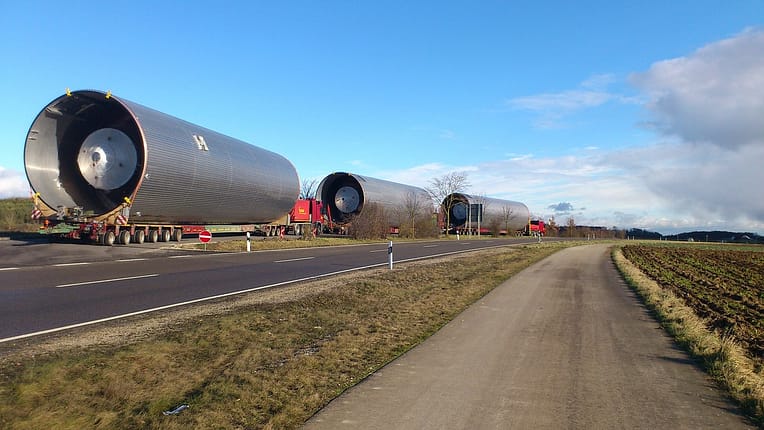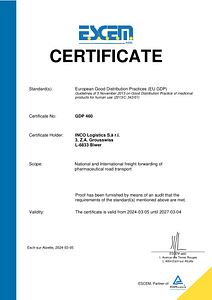Heavy transport is the transport of exceptionally large, heavy or bulky goods that cannot be transported using standard means of transport due to their dimensions and weight. Heavy transports are often a logistical challenge and require special preparations, vehicles and permits to be carried out safely and efficiently.
Typical examples of goods that are considered heavy transports are:
Industrial equipment: Large machines, plant components or entire production facilities that cannot be transported on conventional trucks due to their size and weight.
Construction machinery: Heavy construction machinery such as excavators, cranes or road rollers that often have to be moved on special transport vehicles.
Wind turbines: The rotor blades, tower segments and other components of wind turbines are bulky and require heavy transport to move them from the manufacturing plants to the wind farms.
Large vehicles: Sometimes large vehicles such as locomotives, trams or ships have to be transported over long distances.
Bridge and hall sections: Large bridge segments or prefabricated hall parts can only be brought to their destination with special heavy transports.
Heavy transport requires precise planning and coordination, as it poses special challenges due to the size and weight of the goods. This includes the selection of suitable tran
What preparations and permits are required for a heavy transport?
Extensive preparations and permits are required for a heavy transport to ensure the safety and legality of the transport. The exact preparations and permits required vary by country, state or region, as different laws and regulations may apply. However, in general, preparations and permits for a heavy transport include the following steps:
Planning and route selection: Planning for heavy transport begins with selecting the best route to reach the destination. The route must be carefully selected to avoid obstacles such as low bridges, tight curves or roads with weight restrictions.
Load securing and packaging: The goods must be properly secured and packed to avoid causing damage or endangering other road users during transport.
Special means of transport: Depending on the size and weight of the goods, special means of transport such as heavy-duty vehicles, low-loaders, heavy-duty cranes or heavy-duty ships are required.
Special permits: Special permits are usually required for heavy transport, which are issued by the local authorities or transport authorities. These permits regulate the conditions and restrictions of the transport, including the permitted route, time frame and safety regulations.
Escort vehicles and personnel: In the case of particularly large or heavy
What special vehicles and equipment are used for heavy transport?
Heavy transport requires special vehicles and equipment capable of safely transporting exceptionally large, heavy or bulky goods. These special vehicles and equipment vary depending on the type of goods, local regulations and the specific requirements of the transport. Here are some of the commonly used vehicles and equipment for heavy transport:
Heavy-duty vehicles (heavy-duty trucks): Heavy-duty trucks are specially designed trucks that offer high load capacity and stability. They are capable of transporting heavy goods over long distances and often have multiple axles to distribute the weight evenly and reduce the load on the roads.
Low loader: Low loaders are trailers or semi-trailers with a particularly low loading area. They are used to transport high or bulky goods that would not have enough space on conventional trailers.
Heavy-duty cranes: Heavy-duty cranes are used to lift and load heavy goods, especially if they cannot be loaded in the conventional way. These cranes have a high load capacity and are capable of moving heavy loads.
Self-propelled heavy-duty transporters: These special vehicles are able to move heavy loads on the road without the need for a towing vehicle. They are often used for transporting heavy machinery or equipment.
What are the challenges and risks of heavy transport and how are they managed?
In heavy transport, there are a number of challenges and risks that need to be overcome to ensure safe and successful transport. Here are some of the most common challenges and how they are overcome:
Road and infrastructure conditions: The size and weight of heavy loads can put a lot of stress on roads and infrastructure. Inadequate roads or bridges can pose a challenge. To overcome this challenge, specific transport routes are selected that are suitable for heavy transport. If necessary, temporary reinforcements are made to bridges or roads.
Permits and regulations: Heavy transport often requires special permits from the relevant authorities. It is important that all necessary permits are obtained in good time so as not to delay the transport. All applicable regulations and safety standards must also be observed.
Load securing: Secure load securing is crucial to avoid accidents and damage during transport. Special fastening systems and packaging are used to securely fix the load to the means of transport.
Traffic obstructions: Due to the size and speed of heavy transports, traffic obstructions can occur. To minimise these, transports are often carried out outside rush hours and low-traffic times. Escort vehicles o
Heavy transport
Heavy transport is the transport of exceptionally large, heavy or bulky goods that cannot be transported using standard means of transport due to their dimensions and weight. Heavy transports are often a logistical challenge and require special preparations, vehicles and permits to be carried out safely and efficiently.
Typical examples of goods that are considered heavy transports are:
Industrial equipment: Large machines, plant components or entire production facilities that cannot be transported on conventional trucks due to their size and weight.
Construction machinery: Heavy construction machinery such as excavators, cranes or road rollers that often have to be moved on special transport vehicles.
Wind turbines: The rotor blades, tower segments and other components of wind turbines are bulky and require heavy transport to move them from the manufacturing plants to the wind farms.
Large vehicles: Sometimes large vehicles such as locomotives, trams or ships have to be transported over long distances.
Bridge and hall sections: Large bridge segments or prefabricated hall parts can only be brought to their destination with special heavy transports.
Heavy transport requires precise planning and coordination, as it poses special challenges due to the size and weight of the goods. This includes the selection of suitable tran





